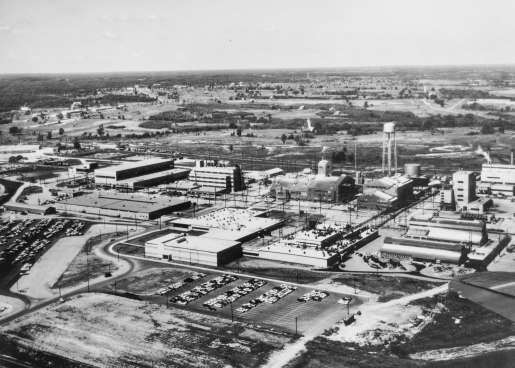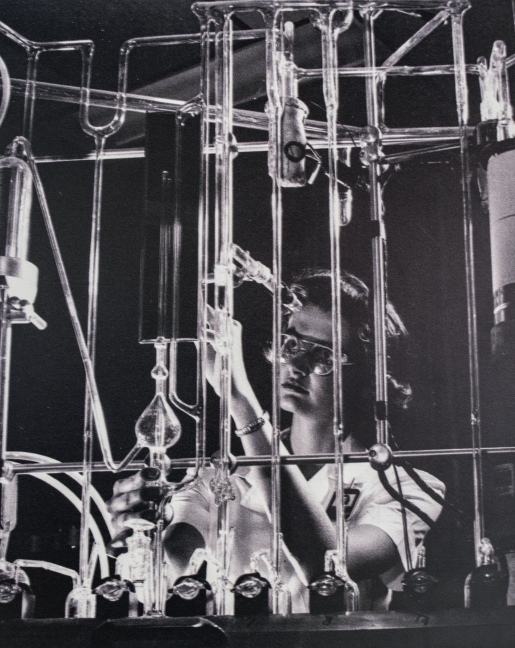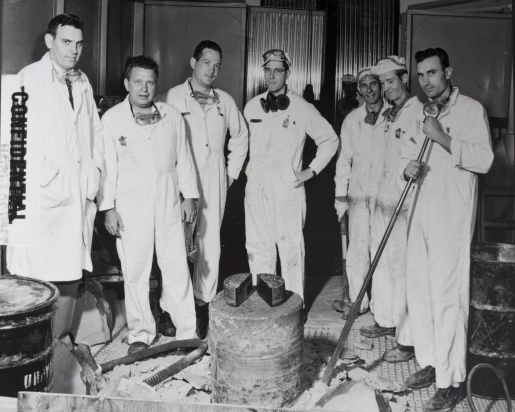The Weldon Spring Site is located in St. Charles County, 30 miles west of St. Louis. The site comprises two geographically distinct, U.S. Department of Energy (DOE)-owned properties: the former Weldon Spring Chemical Plant and former Weldon Spring Quarry.
In 1941, the U.S. government acquired 17,232 acres of rural land in St. Charles County to establish the Weldon Spring Ordnance Works. In the process, the towns of Hamburg, Howell, and Toonerville, and 576 citizens of the area were displaced. From 1941 to 1945, the U.S. Army manufactured trinitrotoluene (TNT) and dinitrotoluene (DNT) at the Ordnance Works site. Four TNT production lines were situated on what was to be the Chemical Plant. These operations resulted in nitroaromatic contamination of soil, sediments, groundwater, and some offsite springs.
Following a considerable amount of explosives decontamination of the facility by the U.S. Army, part of the area was transferred to the U.S. Atomic Energy Commission (AEC) in 1956 for construction of the Weldon Spring Chemical Plant. The plant converted processed uranium ore concentrates to pure uranium trioxide, intermediate compounds, and uranium metal. A small amount of thorium was also processed. The uranium refining process generated waste byproduct called raffinate. The raffinate was stored in four raffinate pits located on the Chemical Plant property. Uranium-processing operations resulted in contamination, which in some locations comingled with contamination left from the explosives production during World War II.
The Weldon Spring Quarry was mined for limestone aggregate used in the construction of the Ordnance Works. The U.S. Army also used the Quarry for burning wastes from explosives manufacturing and disposal of TNT-contaminated rubble during Ordnance Works operations. These activities resulted in the nitroaromatic contamination of the soil and groundwater at the Quarry. In 1960, the U.S. Army transferred the Quarry to AEC, which used it from 1963 to 1969 as a disposal area for uranium and thorium residues (both drummed and uncontained) from the former Chemical Plant.
Uranium-processing operations ceased in 1966 and AEC returned the facility to the U.S. Army. AEC, and subsequently DOE, managed the site, including the U.S. Army-owned Chemical Plant, under caretaker status from 1968 through 1985. Caretaker activities included site security oversight, fence maintenance, grass cutting, and other incidental maintenance. In 1984, the U.S. Army repaired several of the buildings at the Chemical Plant; decontaminated some of the floors, walls, and ceilings; and isolated some equipment. In 1985, the U.S. Army transferred full custody of the Chemical Plant to DOE.
The U.S. Environmental Protection Agency (EPA) placed the Quarry and former Chemical Plant areas on the Comprehensive Environmental Response, Compensation, and Liability Act (CERCLA) National Priorities List (NPL) in 1987 and 1989, respectively. Remediation of the Weldon Spring Site was administratively divided into four operable units (OU): the Chemical Plant OU, the Quarry Bulk Waste OU, the Quarry Residuals OU, and the Groundwater OU. The Southeast Drainage was remediated under a CERCLA removal action and documented through an Engineering Evaluation/Cost Analysis process. Remedial activities concluded in 2001 with completion of the site’s disposal cell — a 41-acre engineered structure designed to contain the site’s waste resulting from the cleanup.
The Weldon Spring Site is open to the public and is an excellent example of beneficial reuse of a former World War II explosives manufacturing and Cold War uranium metals processing facility. The site’s Interpretive Center opened in 2002 and communicates site history, cleanup activities, and current conditions. In 2020, the Weldon Spring Site received the U.S. Environmental Protection Agency’s Federal Facility Excellence in Site Reuse Award. This award recognizes noteworthy restoration and reuse of federal facility sites through innovative thinking and cooperation among federal agencies, states, tribes, local partners, and developers.
The Weldon Spring Site is frequented by birdwatchers, native-plant enthusiasts, hikers, mountain bikers, historians, teachers, and others. A popular public activity is walking the disposal cell stairway and taking in the panoramic view overlooking St. Charles and St. Louis Counties. The planted, 150-acre, native prairie is rich with flowering forbs, grasses, and wildlife. A former haul road has been converted to the Hamburg Trail, connecting the site to the neighboring Missouri Department of Conservation (MDC) public lands, Great Rivers Greenway trail network, and Katy Trail State Park.
About Weldon Spring Site Interpretive Center
Weldon Spring Ordnance Works served the nation during World War II. Weldon Spring Uranium Feed Materials Plant served the nation during the Cold War. Continuing this legacy of service, LM’s Weldon Spring Site in Missouri serves as a community asset, protecting and conserving the environment. Watch this short video about the history and ongoing work at the site.
Department of Energy Office of Legacy Management






